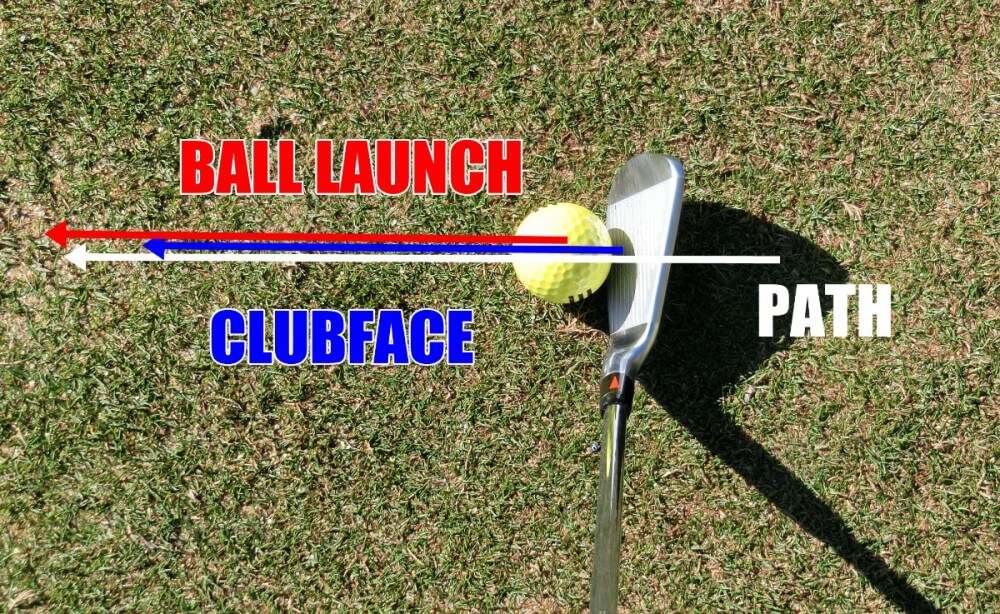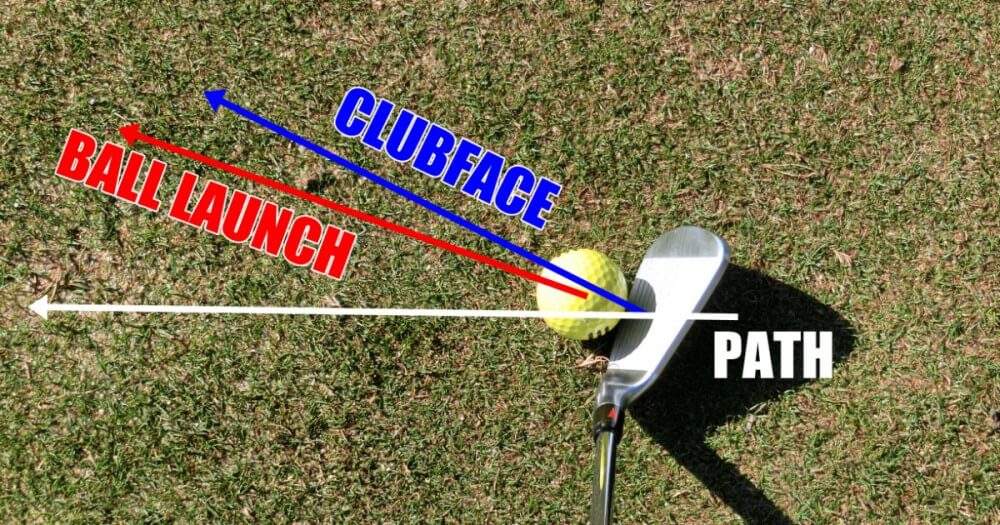Controlling your direction is obviously a hugely important part of golf. However, when questioned, most golfers don’t seem to understand what actually causes a ball to go straight/offline. I know this because I teach golf for a living, and it’s a question I ask each of my students.
While there are many swing-style elements which could contribute to an offline shot, I like to boil it down to what definitively causes a ball to go in the desired direction (or not).
The Facts
The golf ball responds to what we call the “impact interval” – the time in which the ball is in contact with the face of the club; to the golf ball, nothing else matters. So whether you are:
- 6’4″ or 4’6″
- 230lb of muscle or 110lb soaking wet
- Tiger Woods in his prime, or a complete beginner
- Have a weak grip or strong grip
- Long or short swing
- Lifting your left heel in the backswing or keeping it planted
etc., it makes no difference to the result.
While this sounds controversial, it is a fact. The best players are simply great at creating a functional and consistent impact. It is important to state that the difference between you and a top tour pro resides in this 0.75″ or so of space where the club is in contact with the ball.
This is why we can see so many different swing styles on tour being effective – they are simply an individual’s unique vehicle to a functional impact interval.
So many different styles.
This is not to say that swing style is irrelevant – many technical moves can add consistency/improvements to the impact interval. However, if a swing change doesn’t positively effect this small space at impact, it wont affect your golf ball.
Path and Face
The logical progression from that information would be to look at what causes direction. Given a centered strike (sweet spot – more on this in later articles), there are two main elements which determine a shot’s direction – path and face.
Path
Path refers to the direction the club is moving during the impact interval. Most players will have heard of the terms “in-to-out” (referring to a club moving to the right of the target line) or “out-to-in” (referring to a club moving left of the target line).
Images taken from The Practice Manual – The Ultimate Guide for Golfers
The swing path is only really responsible for around 25% of the starting direction of the golf ball. Also, while it is necessary to have a relatively square swing path through impact to achieve the elusive perfectly straight shot onto our target, it is not necessary to have a square swing path to play great golf.
In fact, many top players are able to play great golf with clubs which swing to the right of/left of the target line through impact – essentially hitting a draw or fade shot. Some, such as Bubba Watson, may dramatically change their swing paths from shot to shot to achieve a desired shot shape.
Face
Clubface direction is simply the direction the clubface is pointing during this impact interval (it also includes dynamic lie angle).
This has the biggest influence on starting direction of the ball (often around 70-80%). In fact, a clubface direction which is offline can easily override the swing path of the player. For example, a player may swing the club 3 degrees in-to-out (to the right) and have a clubface which points 3 degrees left – meaning the ball starts to left and moves further to the left.
The player will then often report that they felt they have “come over the top” of it, whereas this was not the case (I can then use Trackman numbers to prove this to them).
A match made in heaven
Effectively, it is the relationship between these two factors which create the direction of the ball. For example, a square swing path and square clubface at impact (sweet-spot strike, barring minutiae) will produce a straight shot with no curvature.
Image taken from The Practice Manual – The Ultimate Guide for Golfers
If the clubface is closed to the swing path, the ball will curve to the left, and vice versa. The amount of difference between the path and the face will determine the amount of curvature, with a bigger difference creating a bigger curvature – all other things relative.
A general rule I like to give beginner players is to learn to control/manage the clubface better. We do this through a mixture of drills and techniques, as well as improvements in awareness.
We then progress to a better understanding, with the general rule of;
Note – While this is not 100% accurate (the ball actually starts around 70-80% between the path and face, favoring the face), it is easier to remember, and functional enough to make appropriate changes.
Image taken from The Practice Manual – The Ultimate Guide for Golfers
For example, if your ball starts on the target line but curves right, your clubface was square the the target at impact, but your swing path would have been more to the left (the more curvature the ball has to the right, the more left the swing path was).
Work On It
There are many dogmatic statements in golf instruction explaining how you ‘must’ swing this way/that way. However, most of this is unfounded – as evidenced by the innumerable functional swings on tour.
The commonality between all tour players is that they all manage their clubface/path relationship really well. And if you want to hit the ball more accurately, this is something you should be working on too. We all work and tinker with our swings endlessly, but have you worked directly on clubface or swing path yet? The answers to better golf lie there.
I use a mixture of drills, techniques and conceptual understanding to make dramatic improvements with my students in this area.




















Pete the Pro
8 years ago
Here’s a discussion that’s a little uncomfortable, but worth a read. The average golfer is not improving whilst elite amateurs, club pro’s and Tour Pro’s are getting better. We have access to the latest technology, Flightscope, Trackman, rangefinders, video analysis, but no improvement (on average). Not since 30 years ago. Yes, I have used a Flightscope for 9 years, so I know a little about this. Are launch monitors encouraging excessively complex instruction and turning people away from the joy of playing golf for the primary reason, for fun? When I was a kid I wanted to hit the ball and make a great score, not know that my 6 iron had a descent angle of 4 degrees, 72mph head speed and 1.42 smash factor. The intersection between the swing direction (plane moving to the right of target) plus the co-efficient of the face disecting the blah, blah, blah… That’s nothing to do with having fun at the golf course. Anyway, I became a Golf Professional because nobody screwed me up with such nonsense. Discuss.
adam young
8 years ago
I agree with the basic premise, but I don’t think any teacher worth his salt is going to be saying that a 4 degree AOA is better than a 3 degree AOA. However, they may use launch monitors to
1. improve performance, and show this improvement clearly to the pupil
2. see the interconnections between all the pieces (before relaying a simple thought to the pupil),
3. encourage experimentation
4. help bridge the gap between feel and real, reducing discomfort with new moves
5. help gain a better understanding of shot patterns etc.
I personally think that launch monitors have got us out of the stone ages of instruction (pure movement focus) and allowed much more freedom for the pupil to self-organize based on their own personal mix of what they are bringing to the table.
Also, I have benefited personally from understanding things such as above. My own long game is now much higher quality and easier to maintain as a result.
Average golfers don’t get better because many don’t take lessons, or listen to the advice of their 20 handicap playing partner/husband.
Pete the Pro
8 years ago
Adam. You make fair points and, yes, the primary factors behind lack of improvement are rooted in failure to take lessons and advice from willing friends/husbands, etc. I’m with you most of the way here. However, I have also watched the results of the incorrect use of a launch monitor to give lessons. If the player is understanding more, having more fun in the learning environment and improving, I think its great. If the player is further confused by analysis, data, complex explanation and information overload, they pack the game in. The joy of playing the game is often extinguished. I am not anti-launch monitor (I used one for 9 years), but I used it the right way. To measure. Not to teach golf.
adam young
8 years ago
Pete – bad lessons can be given with our without tech, and great lessons can be given with or without tech. As with anything, it is about the person using it.
As a teacher, we have to weigh up what the pupil wants and needs, and relay the info to them. This could be as simple as “brush the grass in this direction”, or could be a deeper understanding of D-plane, or how low point affects path.
I am 100% with you and constantly tout the need for simplicity. But everyone needs to be and likes to be taught differently. I have personally benefitted (and know hundreds of others who have) from more detailed numbers.
With all that said, this article doesn’t really have anything to do with launch monitors. In fact, I give simple rules in the article which require no need for specific numbers – just seeing ball flight.